Hussam al-Mahmoud | Khaled al-Jeratli | Hassan Ibrahim
In light of the rapid developments led by Israel in the region, from Gaza to southern Lebanon, reaching Syria and the almost unending strikes on military sites in areas controlled by the regime, the Syrian regime stands as a mere spectator, in line with its behavior regarding the security and military challenges faced by the “Axis of Resistance” to which it has chosen to belong over the past years since 2011, as the Syrian regime’s president, Bashar al-Assad, has not shown any response to the battlefield conditions and the wars being waged by the “allies.”
Al-Assad’s clear desire to distance himself from the conflict has been met with Israeli maneuvers in Quneitra, southern Syria, where they have moved in on the ground, bulldozing some lands and shifting the barbed wire fence on the border between Syria and the occupied Golan.
These movements and Israel’s efforts to “cleanse” its borders of Lebanese Hezbollah, as well as the Iranian influence which al-Assad has widely opened the door to, raise questions about the future of Quneitra and whether it is Israel’s next target after securing its military positions in Gaza and southern Lebanon, and the elimination of top leaders of Hezbollah and Hamas, the latest of whom was the head of its political bureau, Yahya Sinwar, who the Israeli army announced was killed on October 17 during a clash with Israeli soldiers in Tel al-Sultan in Rafah, southern Gaza.
In this lengthy report, Enab Baladi discusses with a group of experts, locals, and researchers the importance of the southern region for Israel and its future in light of current developments and the regime’s cold response to the events.
Israel is on the move; the regime stands still
The southern border with the occupied Syrian Golan is experiencing a relative calm, in stark contrast to the current situation on the Lebanese-Israeli border, which is viewed as an extension of it. Israel is conducting military operations and ground incursions in southern Lebanon, targeting Hezbollah.
The Syrian regime continues a retreat and a stance of neutrality for over a year, having not taken any action since the onset of Al-Aqsa Flood operation in Gaza, and no defensive military preparations have been observed in response to ongoing Israeli incursions inside the demilitarized zone in Quneitra.
Military movements by Iranian-backed militias, including those affiliated with Hezbollah, have occasionally broken the state of inactivity in the region. Over sporadic periods of time, these militias have carried out strikes against Israel, but Israeli planes have retaliated by targeting these groups in Syria and executing assassinations in the area.
The regime’s neutrality has not deterred Israel from moving in the region. Israeli media previously reported that Israeli forces were advancing to establish a security barrier on the border separating Syria from the occupied Golan, while reports of Israeli military vehicles regularly entering Syrian territory since 2022 have been denied by the regime.
Talk of establishing a barrier on the border came alongside the regime’s denial of the entry of Israeli military vehicles into Syrian territory. The pro-regime Al-Watan newspaper quoted the head of the Baath Party branch in Quneitra, Khaled Abaza, as saying that there was no Israeli incursion in southern Syria.
Abaza added, “All that is published about an Israeli incursion into Syrian territory has no basis in truth and is mere imagination of those who spread and promote such rumors.”
The state-run Syrian Arab News Agency (SANA) also reported at the time the governor of Quneitra, Moataz Abu al-Nasr Jamran, denying an Israeli incursion in Quneitra, indicating that “the inhabitants of the villages are living their lives safely.”
Since November 2022, Israeli forces have repeatedly entered Syrian territory, beginning work on establishing a road adjacent to the border.
Enab Baladi’s correspondent in Quneitra then reported that Israeli bulldozers entered Syrian territory, accompanied by military armored vehicles.
The bulldozers began working on creating the road in the far north of Quneitra, specifically west of the town of Ain al-Tinah, at a depth ranging from 100 to 700 meters inside Syrian territory.
Following that, the entry of Israeli military vehicles into the area became frequent, impacting the lives of local residents and farmers who have been prevented from accessing their agricultural lands or approaching them.
Defensive preparations and mine clearance
On October 15, a Syrian soldier stationed in southern Syria, a Lebanese security official, and a United Nations peacekeeping force official reported to Reuters that Israel is moving the barbed wire fence between the demilitarized zone towards the Syrian side and is constructing more fortifications in the area.
The agency noted that Israel’s military movements include airstrikes from the Golan occupied by Israel and potentially from the demilitarized zone dividing it from Syrian territory, which might escalate the conflict between Israel and Hezbollah.
Reuters also reported that a Syrian intelligence officer and a soldier stationed in southern Syria, along with three senior Lebanese security sources, indicated that mine-clearing operations by Israel have intensified in recent weeks.
The sources stated that the mine removal became more pronounced as Israel began its ground incursions at the start of October, targeting Hezbollah along the mountainous area separating northern Israel from southern Lebanon, approximately 20 kilometers to the west, according to Reuters.
A senior Lebanese security source described by the agency said that Israeli forces dug a new trench near the demilitarized zone in October, while another “senior” Lebanese security source told Reuters that mine clearance operations may allow Israeli forces to encircle Hezbollah from the east.
What Reuters reported was preceded by a report published a day earlier by Channel 14 in Israel, regarding Israel’s intention to establish a large land barrier on the border with Syria, to complicate matters for “terrorists” attempting to enter Israel in the future. This barrier would include a double fence, an earthen mound, and trenches.
It added that Israel’s “security apparatus” takes the threats coming from the Syrian border very seriously and with concern, as well as from the eastern border.
The objective of building the security barrier on the border is to obstruct “enemy forces and hostile elements” if they attempt to breach into Israeli territory, as Israel learned lessons from the wall that was previously breached by Hamas in October 2023, according to Channel 14.
Israel completes “Sufa 53”
In continuation of the “Sufa 53” road project, Israeli military vehicles have been consistently crossing the border into Syrian territory to construct the road, which runs parallel to the border strip with the occupied Golan Heights. The road starts from the far northern countryside of Quneitra, west of Ain al-Tinah town, and extends to the southernmost part of the province, reaching the Syrian-Jordanian border.
The road extends 200 meters east of the border to over one kilometer west of the town of al-Hurriya, then narrows toward the south and runs through agricultural land in Quneitra, in an area locals call the “Red Barrels Line.”
For more than 25 years, local residents have relied on farming the lands adjacent to the border, but the Israeli army has uprooted part of these lands and prohibited access to them, according to a correspondent from Enab Baladi in the area.
The road spans over 60 kilometers, with Israel establishing observation points along it, spaced one kilometer apart.
The “Sufa 53” road, extending along the border, is followed south by an earth embankment five meters high, built by Israel at the same time as the road itself was being prepared. Following the embankment is a trench that is five meters deep and five meters wide.
Enab Baladi interviewed a farmer who lost his land due to Israeli movements in Quneitra. He stated that Israeli bulldozers uprooted fig, grape, and olive trees from the land he inherited from his father, which covers an area of four dunams.
The farmer, who requested anonymity for security concerns, added that he attempted to object to the uprooting of the trees from his land, but the Israeli army shot at him and attempted to arrest him without any intervention from the border guard forces of the Syrian regime or the United Nations peacekeeping forces.
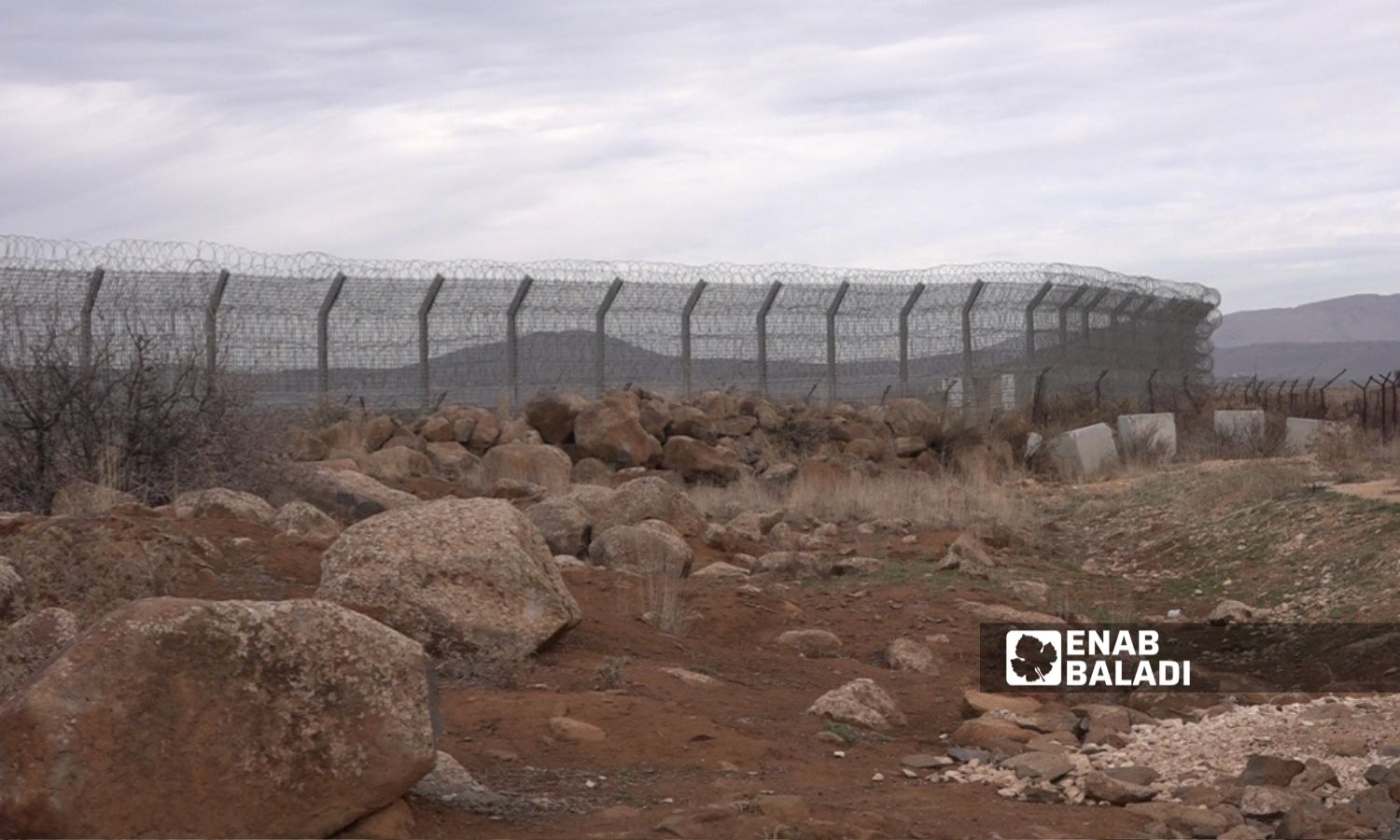
The border strip with the occupied Golan from the town of al-Hamidiyah in southern Quneitra province – September 9, 2024 (Enab Baladi/Zain al-Joulani)
New incursion
The regime’s denial of reports regarding an Israeli incursion in Syria came at a time when Israeli armored vehicles were still entering villages and towns adjacent to the border in Quneitra province, and were continuing to work on preparing the road itself.
On September 21, Israeli forces again advanced into Syrian territory in Quneitra province accompanied by tanks, bulldozers, and trench-digging equipment.
Enab Baladi’s correspondent reported at the time that the Israeli army entered the border strip up to 200 meters deep into Syrian territory and began to raze agricultural lands, dig trenches, and build earthen barriers as part of the “Sufa 53” road project.
Enab Baladi documented the excavation and ground incursion operations near the occupied Golan border with photos.
Although the governor of Quneitra and the secretary of the Baath Party branch in the same province denied any Israeli incursion into the province, there was no comment from the Ministry of Defense of the regime on these movements.
Israeli reporters’ cameras have previously captured the work of Israeli military machinery within Syrian territory during different time periods, the latest of which was in November 2022, when the Israeli channel “Kan 11” published a report that included video recordings from Syrian territory.
What are regime forces doing?
The Syrian regime took control of the provinces of Quneitra and Daraa in July 2018, after more than four years of the presence of opposition factions in most of the region.
The regime’s entry into the area did not bring about any change, as border guard forces returned to their positions; however, they did not intervene in the movements of Israeli armored vehicles in Quneitra. Meanwhile, Israel has repeatedly bombed sites in the region, claiming they belong to the Iran-backed Hezbollah militia.
Since the escalation of Israeli strikes in Lebanon in September, and the possibility of extending the escalation to southern Syria, Quneitra has not seen any military change from the regime, which did not bring any military forces to the area, according to military sources interviewed by Enab Baladi in the province.
A first lieutenant officer, defected from the regime army, who previously worked with armed opposition factions in Quneitra, told Enab Baladi that the area has not seen any changes or reinforcements, except for some rudimentary fortifications by regime forces in certain military positions, such as building sandbags and fortifications around border guard points.
The officer, who currently resides in Quneitra and requested to remain anonymous for security reasons, added that the border is considered unsafe for Syrians, especially for border villages, as Israel occasionally arrests civilians from the area and its soldiers shoot at civilians without any intervention from the regime’s forces.
What about western Daraa?
A few kilometers from the area where Israeli bulldozers are working in Quneitra province lies the western countryside of Daraa, with part of the Yarmouk Basin region forming a portion of the border with the occupied Golan.
In the same area where regime border guard forces returned in 2018, the military reality has not changed, according to a local source from the same area, confirmed by an Enab Baladi correspondent in Daraa.
Ahmed, a media activist from the western countryside of Daraa who lives in the same region, requested to withhold his full name for security reasons, told Enab Baladi that the area near the border has not seen any changes, and no military reinforcements have been directed towards it, while regime forces are active within the province, around cities, towns, and villages opposed to them.
He added that the regime has reinforced its presence in the western countryside of the province around the cities of Jassim and Tafas, where residents oppose the presence of the regime, while no military vehicles or soldiers have moved to the border with the Golan.
Enab Baladi‘s correspondent in Daraa also confirmed that regime forces are only active internally around cities and towns in Daraa, and that the western countryside of the province has not witnessed any military or security movements in the area adjacent to the border, which was also affirmed by a military source in the Syrian opposition factions, who refused to mention his name for security reasons, noting that the area has not seen military movements over the years, even during the current escalation in Lebanon.
Israel is interested.. Why?
Rifat Amash, a political activist residing in the occupied Syrian Golan, explained to Enab Baladi that the current Israeli movements, and the entry of Israeli forces into the disengagement zone under the pretext of building a security fence, resemble establishing borders within borders and creating a separation between internal and external borders.
Accordingly, Israel has entered Syrian territory at varying distances from Mount Hermon to Tal al-Faras, and has bulldozed agricultural lands belonging to farmers in the villages of the Quneitra countryside. Its activities included the construction of earthen berms and digging a trench.
These movements contradict what was stated in the disengagement agreement (signed on May 31, 1974) and the resolution drafted by the United States and Russia, which was adopted by the Security Council members in June 2018, prohibiting any military activity in the buffer zone, including any military operations by the Syrian armed forces.
They also contradict Security Council Resolution “338,” which was issued on October 22, 1973, and demanded, among its three provisions, a ceasefire on all fronts of the October War.
Regarding the importance of Quneitra to Israel, Amash explained that the governorate contains ancient Roman ruins and holds historical and geographical significance as it is the largest city near the borders, housing the provincial center which is still partly occupied and surrounded by revealing volcanic hills, such as Tell Abu al-Nida and Tell al-Aram, along with other smaller hills to its north and south, and it is said to be located on a rich water reservoir.
Amash rules out the possibility that Israel will escalate and cross its barbed wire to occupy additional areas of Quneitra, clarifying that Israel could have conducted a ground incursion across this border long ago, as there is no resistance on this dormant front. However, this does not negate concerns about the presence of militias close to Iran, but Israel’s war technology makes the area clearly exposed and reduces security concerns from Quneitra, considered a secure border for Israel for decades.
Amash interpreted these Israeli movements as part of the Israeli settlement project, stating that the Israeli ambition does not stop at advancing a few kilometers into Quneitra behind the borders, as the land cut off by Israel from Syria to establish a security belt extends over thousands of dunams from Mount Hermon to Hamiya to the south on the Golan border.
What about expansion intentions?
Samih Ayoub, a Syrian journalist and political analyst from the Golan, explained to Enab Baladi that after the Al-Aqsa Flood operation, Israel began a policy of expansion and erasure of Gaza’s landmarks, while putting a plan for the evacuation of the West Bank and the occupation of southern Syria. In its view, this may help ignite multiple fronts simultaneously to create justifications that position it before the world as besieged and at war for existence.
The Israeli movements are a “pulse-checking” operation toward the regime or a confrontation with the Iranian presence to obtain a justification for advancing and occupying the area (Quneitra) under the banner of the security belt.
Samih Ayoub, Syrian journalist and political analyst from the Golan
The Israeli concern is manifested in the presence of Iranian forces along the ceasefire line or near it, and indeed more than one drone has been launched from Syrian territory toward the occupied Golan. However, all of this amounts to little more than a pretext for expansion, as security concerns about the borders conflict with the state of security that the Syrian regime has provided for Israel’s borders since 1973, according to Ayoub.
Ayoub interpreted the Israeli movements as a “pulse-checking” operation toward the regime or a confrontation with the Iranian presence to obtain a justification for advancing and occupying the area under the banner of the security belt.
The regime is dealing coolly
Everything is within the realm of what is natural and reasonable for the Syrian regime. Cooking shows and sports programs broadcast through official and close media outlets, such as Sama channel, do not indicate that war is on the horizon, with continuous media coverage of what “Axis of Resistance” media convey regarding operations and statements concerning the situations in Gaza, southern Lebanon, Yemen, and Iraq, alongside statements from the Iranian ally.
The regime’s stance regarding the movements in Quneitra aligns with its recorded position on the province itself, as it has long exploited it since Hafez al-Assad’s rule for political purposes, under the pretext of illustrating the “barbarity of the enemy,” maintaining its ruins and preserved remnants, and leading delegations and tours for observation and “taking lessons.”
The Syrian regime has shown little interest in addressing the Israeli movements along the Quneitra border and has even gone further by denying their existence altogether. However, the denial itself came in a manner that does not match the seriousness of the event and the sensitivity of the phase, as the Quneitra governor and the secretary of the Baath Party branch took on the task of denying the existence of Israeli movements on the Quneitra border, without any comment from the Ministry of Defense or the Ministry of Foreign Affairs, the two ministries usually concerned with matters related to the state’s sovereignty and territorial integrity.
The coldness and escape from reality exhibited by the regime do not negate Israel’s practical intention to implement its vision and project, in which Syria is a station. Strategic expert and non-resident researcher at the Stimson Institute in Washington, Amer al-Sabaileh, clarified to Enab Baladi that Israel’s move to work in the region on the idea of dismantling arenas and segmenting fronts, transforming them into a security depth, necessarily implies that Quneitra is fundamental in the equation of the Golan front. Currently, entry is important for Israelis as they attempt to end the Iranians’ ability to activate any front, especially with the diminishment of attacks on Hezbollah and the beginning of the retreat of the threat coming from Lebanon.
Staying in this area currently is essential for Israel to prevent any activation of this front, at a time when the operation can extend beyond Quneitra, reaching areas related to Hezbollah’s logistical supply, making areas like al-Qusayr and the borders with Iraq focal points for Israel.
Amer al-Sabaileh, Strategic expert and non-resident researcher at the Stimson Institute in Washington
These observations, according to al-Sabaileh, suggest that activating the Golan front is one of the remaining options for Israel, and Israel will not abandon this area easily. It will redraw it within its security vision for this geography, and remaining in this area currently is crucial for Israel to prevent any activation of this front, while the operation may extend beyond Quneitra, reaching matters related to the logistical supply of Hezbollah, making areas like al-Qusayr and borders with Iraq points of interest for Israel.
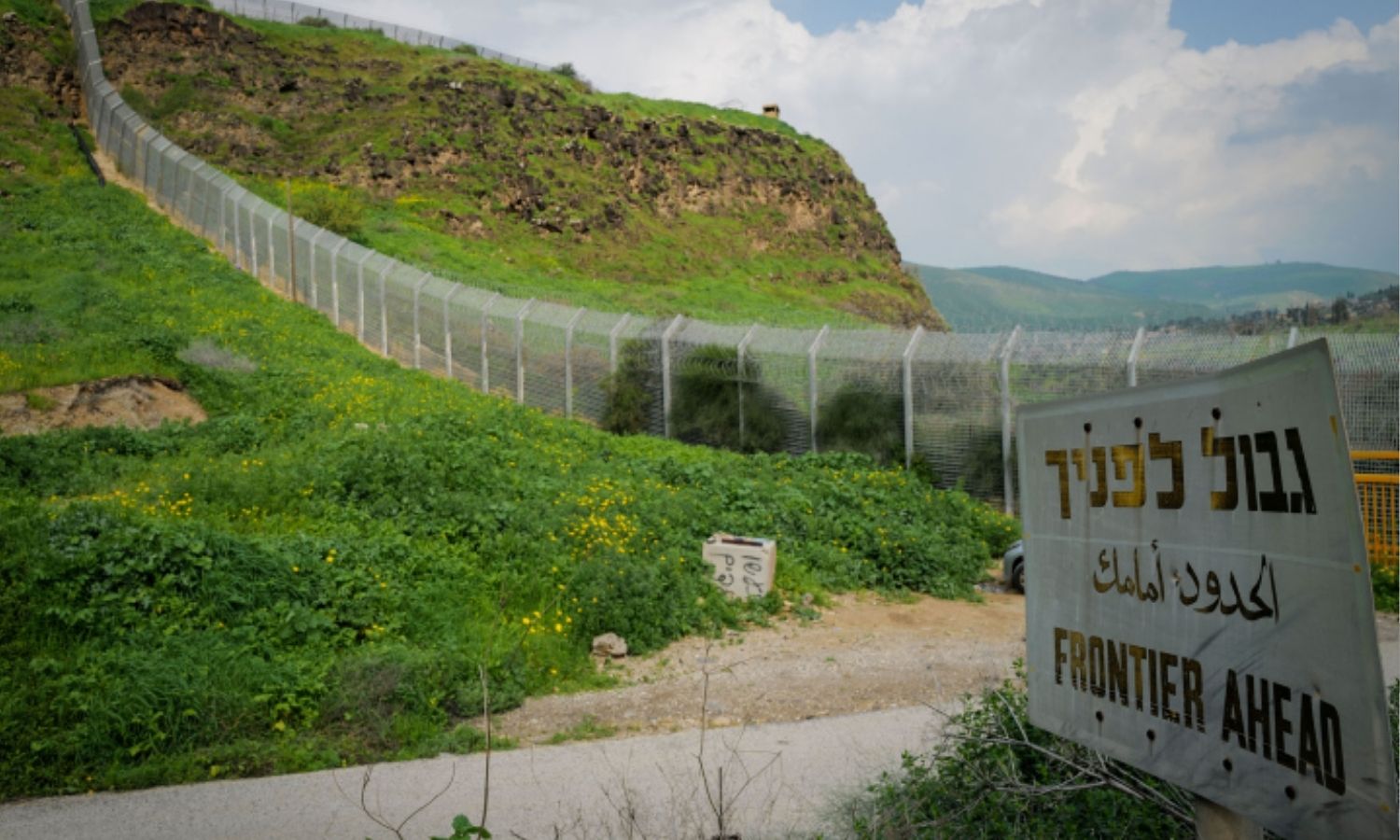
The buffer zone between the Syrian border and the occupied Syrian Golan on the Israeli side (Flash 90/Michael Giladi)
Quneitra..
Iranian playground under Moscow’s gaze
For years, Iran has been the most interested foreign player in southern Syria. This area is a direct front with Israel and a bridge of communication with the Lebanese Hezbollah, securing Tehran a strategic depth in a region filled with “enemies.” Iran has been an ally of the regime, providing it with military, political, and economic support to remain in power, and worked to establish a presence in the southern flank of Syria.
Iran has significant influence in the cities and towns of southern Syria through its arms and militias, including the Revolutionary Guard Corps and Hezbollah. It has around 20 military sites in Quneitra, 16 in Daraa, and 13 in As-Suwayda.
In December 2020, the Israeli Alma Research Center revealed the presence of 58 sites and areas where Iranian-affiliated units are deployed in southern Syria, distributed across 28 locations, where a unit called “the Southern Command” is based, in addition to 30 other locations housing “cells” belonging to a group called “Golan File.”
The center reported that the Southern Command unit is affiliated with Hezbollah and consists of Lebanese elements, whose primary role is to establish an operational infrastructure for all of the party’s activities in southern Syria, focusing on the border area with Israel.
As for the Golan File unit, its goal is to create infrastructure for intelligence gathering for cells that operate as an agent for Hezbollah and carry out operations against Israel. The center considers that these two units pose a continuous operational and intelligence challenge to Israel and regional stability.
Iranian entrenchment is still present, despite the growing role of Russia after the Al-Aqsa Flood operation in establishing stability along the border between Israel and Syria, solidifying over ten observation points along the line separating the Golan Heights, and conducting military patrols in the south in early November 2023, after an absence lasting more than a year.
For months, focus has shifted to southern Syria, which has become a flashpoint in the path to ignition. Enhancing the Russian presence in southern Syria could increase pressure on Iran or help alleviate the Iranian-Israeli confrontation in southern Syria, even if Moscow cannot replace or eliminate Iranian influence, according to an analysis by the Malcolm Kerr-Carnegie Middle East Center.
A pressure card and ground support line
The reduced role of Russian forces and the regime in southern Syria in recent years has allowed Iran to maintain its influence there, even though it has not completely filled the vacuum. The circumstances have become favorable for its expansion due to the regime’s limited economic resources and the weakening of the positions of both the Syrian regime and Russia, according to the Malcolm Kerr-Carnegie center.
Iran’s objective to exploit the geostrategic significance of southern Syria has faced obstacles and challenges, facing a demographic challenge on a macro level, as the Druze majority in As-Suwayda and the Sunni population in Daraa hinder Tehran’s consolidation among the local population.
In Quneitra, the situation is different, as its people have historical grievances against Israel due to its occupation of the land. Additionally, the Druze and Christian minorities have a tense relationship with the Sunni majority, which strongly opposes the regime, providing an opportunity for Iran to extend its influence further, according to the center.
Marwan Farzat, a political analyst specializing in Iranian affairs, stated that Quneitra has substantial strategic value for Iran and its militias; it has become a front and a new card that Tehran has played against Israel over recent years.
He added that this has led to the widening of the front line between Iran and Israel; the old front line between them was 79 kilometers (which is the Lebanese-Israeli border). With Iran’s control of Quneitra, the length of the front line between Iran and Israel has increased to 155 kilometers (after adding 76 kilometers for it, which is the length of the Syrian-Israeli border), meaning that the front line has nearly doubled, which is extremely important for Iran as a leverage against Israel.
According to Farzat, the second importance of Quneitra lies in the fact that Iran possesses a ground support line connecting Tehran to Quneitra via Iraq, meaning it can supply this front with weapons, ammunition, and fighters if the front opens up. He highlighted Iran’s ability to bring in new fighters from other countries that have not previously engaged with Israel, such as the Pakistani Zainabiyoun militias, the Afghan Fatimiyoun, the Popular Mobilization Forces from Iraq, and even fighters from the Yemeni Houthis, enabling them to drain Israel if escalation occurs on this front or to engage directly with it if a major war breaks out.
The analyst believes that Iranian bases in Quneitra and south-western Damascus are among Israel’s targets, while ruling out that Israel would escalate on this front in the near future before surrounding Hezbollah in Lebanon and weakening its strength, ensuring it does not pose a real threat should another front open. This is similar to Israel’s actions in Lebanon, where it did not begin its war until it secured the Gaza front completely, encircled it, and eliminated it from the military equation.
Will Tehran withdraw?
On April 24, a source close to Hezbollah told Agence France-Presse that Iran has reduced its military presence in Syria, focusing on its withdrawals from Daraa and Quneitra provinces in southern Syria.
The agency cited an unnamed source stating that Iran’s withdrawal from southern Syria began after an airstrike attributed to Israel on January 20, which resulted in the death of five members of the Iranian Revolutionary Guard Corps (IRGC) in Damascus; however, Iranian forces still remain in other parts of Syria.
Analyst Marwan Farzat does not believe that Iran will withdraw from Quneitra; it is a very important area for it, and he anticipates that after some time, it will start to provoke Israel from the Quneitra front and might escalate there to pressure Israel into halting the conflict.
The political analyst pointed to the fine line between escalation aimed at pressuring to stop the war and escalation that may broaden the battlefield, potentially leading the region into larger conflict, predicting that the region may witness increased escalation in the coming days.
The 1974 Disengagement Agreement
The disengagement agreement (May 31, 1974) contributed to the immediate cessation of hostilities on the Golan front, including details to delineate the military positions of Syria and Israel along lines “A” and “B.”
The line “B” is referred to as “Bravo,” while “A” is called “Alpha.” The agreement stipulated the separation of forces according to the following principles supported by illustrative maps:
All Israeli forces remain west of line “A” as depicted on the map, except for the area of Quneitra, which remains west of line “A1.”
All territory located east of line “A” is managed by Syrian authorities, allowing the return of Syrian civilians to these areas.
The buffer zone: Located between lines “A” and “B,” this is a separating area between Israeli and Syrian forces, overseen by the United Nations Disengagement Observer Force (UNDOF).
Syrian forces are stationed east of line “B,” where they keep limited forces in this area.
Both Syria and Israel commit to reducing forces and armaments in specified areas on both sides of lines “A” and “B.”
The agreement calls for a reduction of Israeli and Syrian forces in three parallel areas as follows:
- The first area (closest to the UN buffer zone): approximately nine kilometers wide. Each side was allowed to have up to 6,000 soldiers. Each side could possess up to 75 tanks and 36 light artillery pieces.
- The second area: also about nine kilometers wide. No long-range artillery or surface-to-surface missiles were permitted. Each side could have up to 450 tanks and an unlimited number of light artillery pieces.
- The third area: wider than four kilometers but also includes the first two areas, making it about 22 kilometers wide.

Maps illustrate the demilitarized zone between Syria and Israel (US State Department Office of the Historian)
Maps illustrate the demilitarized zone between Syria and Israel (US State Department Office of the Historian)
The UNDOF was established with specific tasks related to maintaining the ceasefire and ensuring full compliance with the agreement, comprising about 1,250 troops from non-permanent members of the Security Council, responsible for monitoring adherence to disengagement conditions and providing regular reports to both parties at least once every 15 days.
It was agreed that the force would be armed only with defensive weapons to be used for self-defense. The UN force was stationed in the buffer zone, which ranges from 330 meters to ten kilometers wide, with an area of about 235 square kilometers, and began its mission in July 1974 under the command of General Gonzalo Briceno from Peru.
if you think the article contain wrong information or you have additional details Send Correction
النسخة العربية من المقال
-
Follow us :













 Israeli bulldozers and soldiers on the border between Syria and the occupied Golan (Modified by Enab Baladi)
Israeli bulldozers and soldiers on the border between Syria and the occupied Golan (Modified by Enab Baladi)





 A
A
A
A
A
A
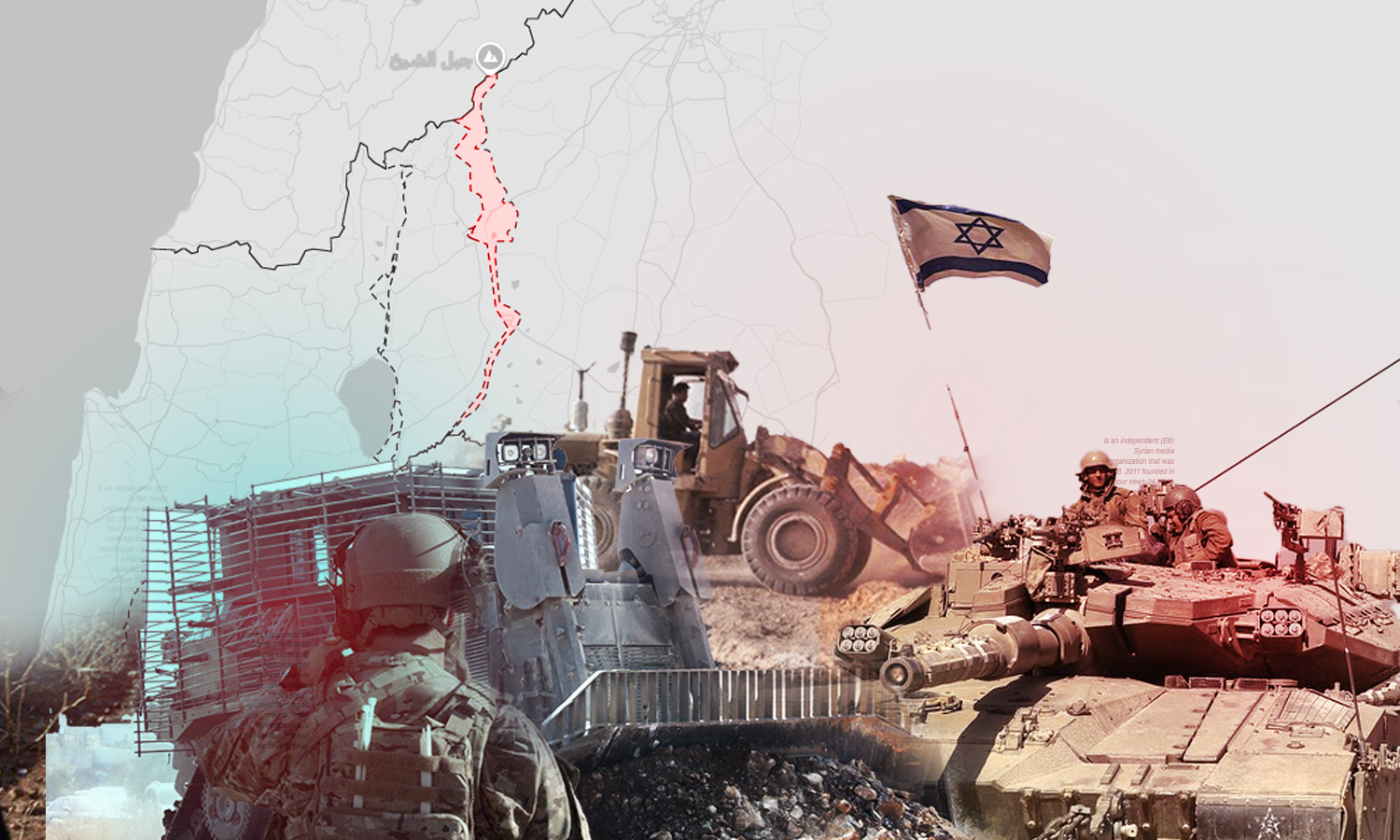
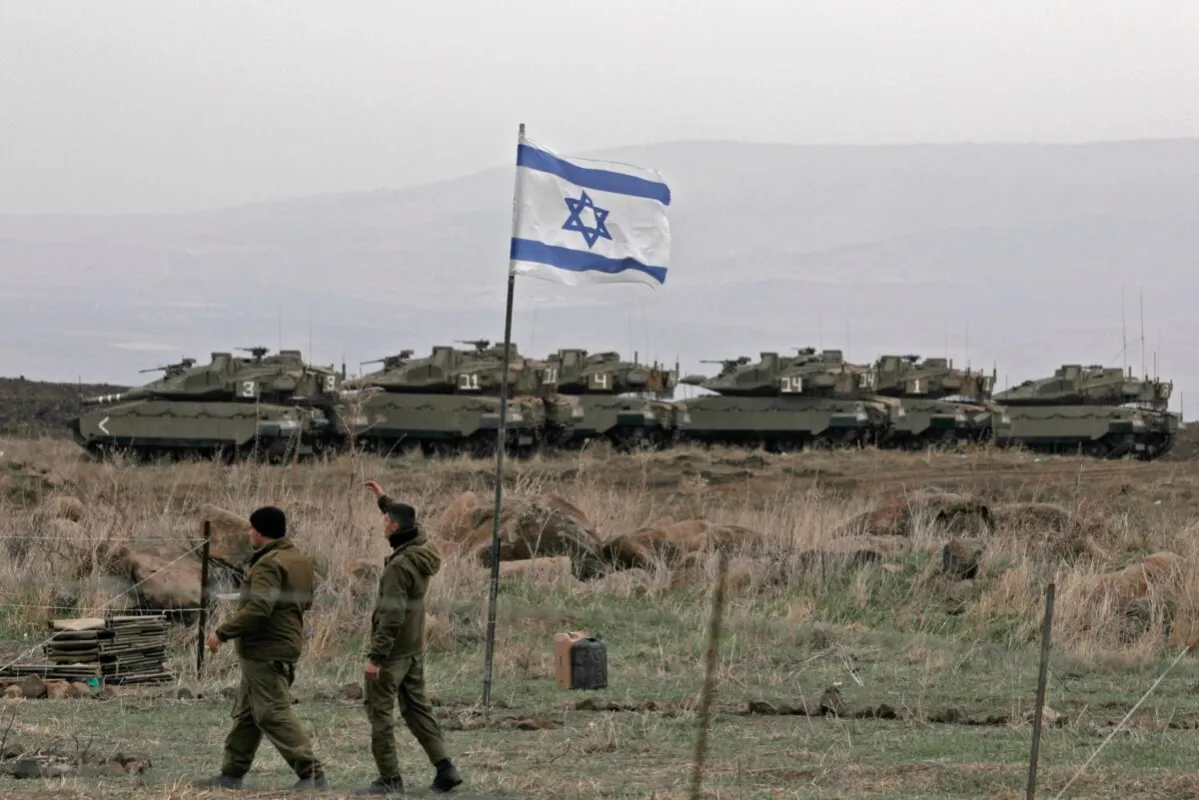


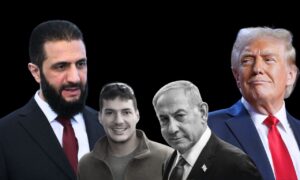
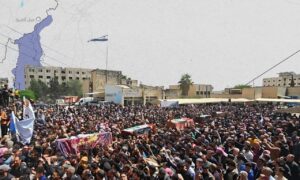



 More In-Depth
More In-Depth